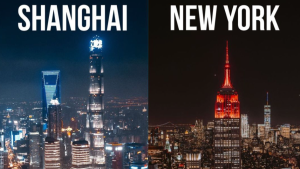How Oppenheimer Reveals About Japan’s Self-Denial on WWII
Oppenheimer finally opened in Japan on March 29th. Beginning with a series of investigations and accusations against Oppenheimer, best known as the “father of the atomic bomb,” led by the U.S. government in the 1950s, the movie delineates a tortured live led by a man whose research and invention brought about massive deaths.
The most prominent reaction from the Japanese audience focused on what they claimed to be a lack of depiction of Japanese victims of the nuclear bombs.
Such reaction is quite consistent with Japan’s enduring attitude towards nuclear bombing over many years, where harm brought by the nuclear bombing is emphasized at the expense of reflection on its own military aggression-the very action that have invited the nuclear bombing in the first place. For a nation that inflicted rampant wars on the Asia Pacific area, Japan seems quite forgetful to campaign against nuclear bombs from the standpoint of a miserable and innocent victim without even so much as mentioning its aggressive past.
It feels ironic that Japan would choose Hiroshima, the first city in the world to be bombed by an atomic bomb, for the national premiere of the movie. Hiroshima hosted a special screening of Oppenheimer on March 12, followed by another screening in Nagasaki on March 18th.
Screenings that caught some Japanese off guard
In the narratives that Japan has crafted and promoted over the years, nuclear explosions serve only as a cause for domestic mourning rather than a reflection on the war as well. The sentiment echoes in reviews of the movie Oppenheimer, where former mayor of Hiroshima protested that “From Hiroshima’s standpoint, this movie doesn’t depict the horrors of nuclear weapons sufficiently.”
Meanwhile, comments made by the guests attending the Hiroshima premiere felt superficial and frivolous. One attendee said “Oppenheimer seems to be a fragile and sentimental person, which is why this movie was made, and it gives us a chance to think about what nuclear weapons are all about.” Another remarked, “This movie makes us think about a lot of things. Peace is the best, and I hope that young people will work hard not to lose the age of peace”.
Their comments contrast sharply with those made by guests attending the Nagasaki premiere who obviously have put more thoughts into their remarks.
For example, Tomonaga Masao, the president of Nagasaki’s “Victims’ Notebook Club,” an organization of nuclear bomb survivors, said that while some people might think that the film doesn’t include sufficient depiction of the civilians who were bombed, there are dozens of specific scenes showing Oppenheimer’s utter shock at the ground situation, which is more than enough.
Also present at the Nagasaki event was Maeshima Kazuhiro, professor at Japan’s prestigious Sophia University, who said the movie demonstrates a shift in American views on nuclear bombing, noting that it would have been unimaginable for the U.S. to produce such a movie at the turn of the 21st century, and that Oppenheimer showcases an introspective and critical stance Americans are now taking on the matter.
Both Tomonaga Masao and Maeshima Kazuhiro showed depths and seriousness in their remarks about the movie. For in fact, there is more than one scene in the movie that exhibited how Oppenheimer was shocked, and traumatized, after witnessing the sufferings of the victims.
For example, in the celebratory scene in America hailing the success of nuclear bombing, the movie uses visual language to display the immense harm “black rain” could inflict on human body. “Black rain”, a combination of dust and water vapor, is the highly damaging byproduct of the atomic bomb explosion.
The scene of the cheering crowds is abruptly ended with a flash of light symbolizing the nuclear explosion, followed by a scene of empty chairs showered in the black rain, setting a stark contrast to the festive scene few seconds prior.
 Not long after this shot, the audience is shown a black sculpture symbolizing a body instantly carbonized by the nuclear blast. This sculpture draws its inspiration from a photo of the nuclear victims, “Burnt to a crisp”, which was exhibited at the Nuclear Bomb Museum in Nagasaki.
Not long after this shot, the audience is shown a black sculpture symbolizing a body instantly carbonized by the nuclear blast. This sculpture draws its inspiration from a photo of the nuclear victims, “Burnt to a crisp”, which was exhibited at the Nuclear Bomb Museum in Nagasaki.
These two scenes alone provide ample evidence of the filmmakers’ respectful attitudes towards history as the tragic situation of the victims in Hiroshima and Nagasaki was taken into careful consideration during the production of the movie.. It is a fact noted by university students participating in the Nagasaki premiere, but conveniently left out or overlooked by the former mayor of Hiroshima.
The “emotion-evoking” Hiroshima Memorial Museum and the “fact-based” Nagasaki Museum
From the above-mentioned report, we can see that Hiroshima and Nagasaki screenings have displayed two completely different vibes: while guests in Hiroshima kept emphasizing their feelings being hurt by the lack of direct depiction of victims, those in Nagasaki were able to appreciate the movie’s artistic portrayal of historical facts through careful observation.
The two memorials for the nuclear bombing in Hiroshima and Nagasaki also contributed to the contrast.
From its official website we gather that the Hiroshima Memorial Museum, officially named the Hiroshima Peace Memorial Museum, chooses to place its emphasis on the experience of the civilian victims of the nuclear bombing, with the danger and hazardous consequences highlighted in the exhibition.
The most emotionally evocative section of the exhibition is the third, which includes a large number of specific names of individuals who were killed or injured in the bombings, along with displays of their suffering afterwards.
Titled “Shouting of the Souls,” this section exhibit the artifacts left by the dead and injured, along with texts that can easily elicit emotional reactions from the visitors.

The section on the city of Hiroshima and the Second Sino-Japanese War also included that segments introducing how some of the Hiroshima troops transferred to China were separated from their families, as well as how captives, civilians, including children, were slaughtered by the Japanese army in the Nanking Massacre.
As we can see, the main theme of this memorial can be summarized as “war is wrong because it inflicts death and suffering on ordinary people”.
However, the Nagasaki Nuclear Explosion Museum adopts a different approach. Its exhibits prioritize the impact of the nuclear bombing on the city, such as the tragic state of architectures in Nagasaki after the bombing.

The museum also exhibits distorted artifacts, such as coins, pens, lunch boxes, glass bottles, which underwent deformation due to high temperatures brought by the nuclear bombing.

It is not difficult to see a divergence: the Nagasaki Nuclear Explosion Museum plans to illustrate the devastating power of nuclear bombs from an objective point of view, while the Hiroshima Memorial Museum Hiroshima’s archive tells the story through individual people.
The divergence on perspectives finds its expression not only in the two memorials, but throughout the Japanese society.
A not-so-unconditional objection to war
The nuclear bombing museums in Nagasaki and Hiroshima were renovated in March 2016 and June 2019, respectively. After visiting both museums, a reporter from the West Japan News identified the approach of the Hiroshima Museum as “appealing to the heart,” and that of Nagasaki as “Scientifically objective”
Clearly, the two approaches represent the two distinct attitudes permeating the Japanese society towards the nuclear bombing and even World War II:
On the one hand, as the only country in the world to have been bombed by nuclear bombs, and where the perpetrators of the war – the Japanese military and the Emperor – were never held accountable, Japan tends to position itself as the victim of World War II. Far-right remnants in the Japanese society also contributed to the popular perspective of “anti-defeat but not anti-war”, which only sees the cost of its defeat.
On the other hand, even under the pressure of the right-wingers, there are still people who are able to perceive the nuclear bombing as a lesson and a constant reminder of the terror of a nuclear war. And this perspective, which can only be derived from someone reflective on instigating the war, advocates showing the horrors of the war and Japan’s losses after the atomic bombing objectively, without a subjective emphasis on Japan as the sole victim.
The vastly different feedback from the Oppenheimer screenings and museums in Hiroshima and Nagasaki can all be attributed to the abovementioned divergence in perspectives. In an environment where two drastically different attitudes coexisted, the collective society’s capacity to think was involuntarily sealed. Because neither attitude, be it ”anti-defeat” or “reflection”, can get around the fact that Japan’s conservative forces have covered up Japan’s World War II crimes. A vacuum has thus been created: no one is asking why war occurred in the first place. The only consensus the Japanese society is able to arrive at is a simple “war is wrong”.
With that societal consensus comes the following questions raised by a Japanese netizen: why are Japanese war movies lopsidedly anti-war, without giving spotlight to the “victory” of Japan’s imperialist aggression in East Asia and the achievements of the Japanese aircraft carriers?
Another Japanese netizen responded as follows: whenever soldiers and weapons are depicted in the movie, Japanese with “war allergies” will come out against it, and neighboring countries will make a fuss. In the end, Japanese directors can only go for shallow plots, where the protagonist’s family members die, earning the movie some cheap tears by resorting to the brutality of war. The audience can comfortably think of themselves as the righteous party by casting the army as the evil one. War in those movies often fades into the backdrop. Audiences are left with superficial thoughts and feelings, such as the main character is pitiful, peace is important, no war is justifiable, and the Japanese army is evil.
This Q&A session serves as a classic example in illustrating how the topic of war faced by modern Japanese is a heavily censored one: nobody is able to truly learn about the war because the lingering domestic conservative forces restrict reflections upon the war. The opposition of neighboring countries, especially China and South Korea as victims of the Japanese aggression, against public discussions of the war in graphic detail also needs to be taken into consideration.
Therefore, in Japan, the subject of war is destined to be shielded from the core conflict. Consequently, Japan as a country exist in a paradox of “defeated, but not completely defeated”, advocating blindly for a anti-war stance where no brain is used and needed.
Having come this far, we can see clearly the conflicted attitude of Japan on war through its national sentiment regarding the Oppenheimer movie, most notably reflected in Hiroshima and Nagasaki screenings. We can only say that we hope that the Japanese people will learn a lesson from the facts displayed in their museums, and that the alarm bells will ring long enough for them to forgo any ambitions for war- a fantasy of Japan that the whole humanity will come to pity.



